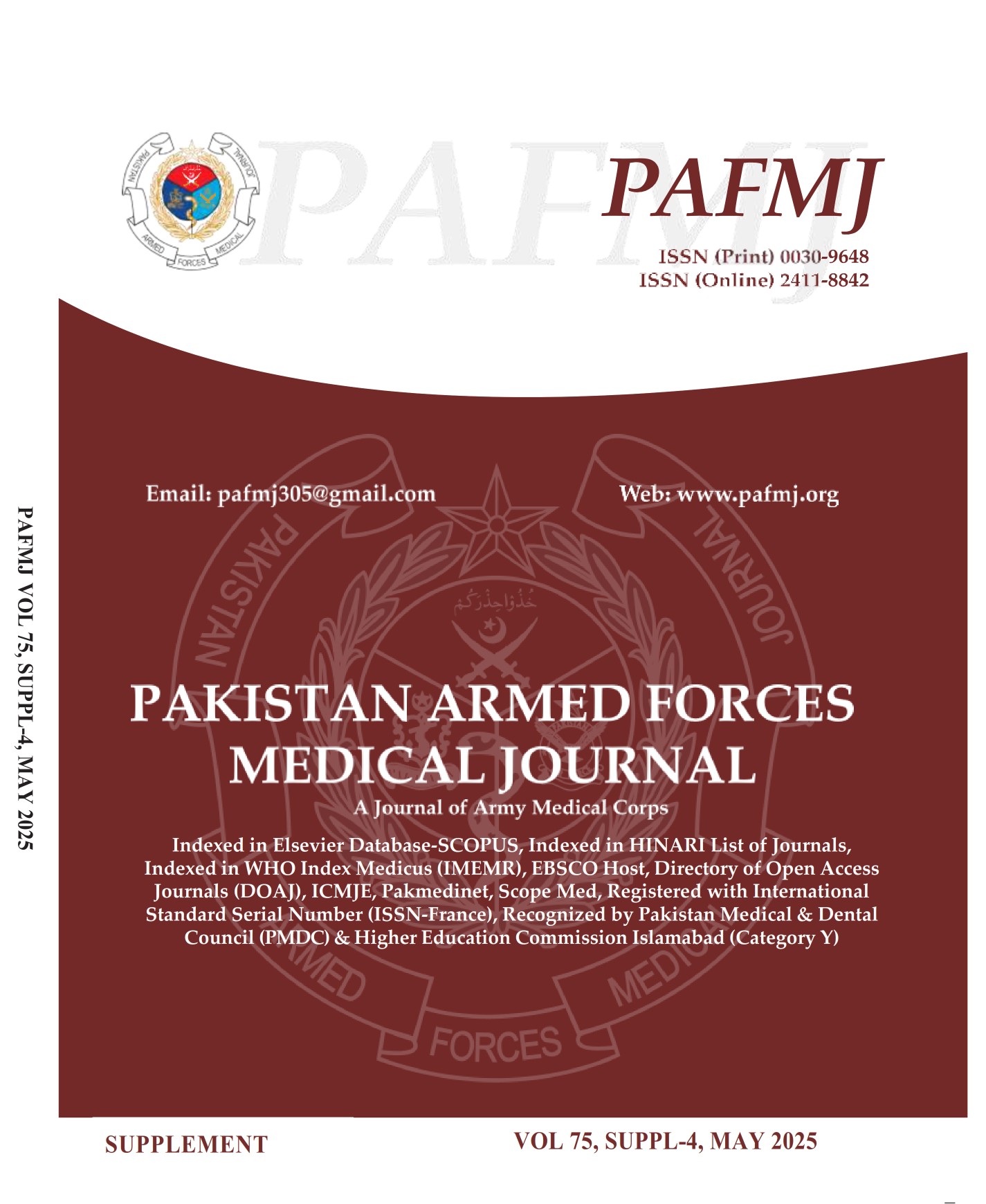Comparison of Outcome of Induction Chemotherapy In Pediatric Acute Lymphoblastic Leukemia Between Standard Risk and High Risk Group
DOI:
https://doi.org/10.51253/pafmj.v75iSUPPL-4.7011Keywords:
Acute lymphoblastic leukemia; high-risk; remission; standard riskAbstract
Objective: To compare the outcome of induction chemotherapy in paediatric acute lymphoblastic leukaemia between standard risk and high-risk groups.
Study Design: Prospective Comparative study
Place and Duration of Study: Paediatric Oncology Department, Combined Military Hospital, Rawalpindi Pakistan from Sep 2018 to Aug 2020.
Methodology: All cases of paediatric Acute lymphoblastic leukemia, who completed induction chemotherapy were included in the study. They were divided into two groups on the basis of National cancer institute criteria. Standard risk group received dexamethasone, vincristine and peg-asparaginase while high-risk group received dexamethasone, vincristine, peg-asparaginase and daunorubicin. Bone marrow examination was carried out at day 8 and 15 and then at the end of induction to document remission status.
Results: A total of 233 patients of Acute lymphoblastic leukemia were included in the analysis. One hundred and twenty (51.51%) patients were in standard risk group and 113(48.49%) were in high-risk group. Remission after initial marrow was significantly higher in standard risk group as compared to high-risk group 101(90.17%) vs 58(55.77%), p=<0.001). However remission after day 29 marrow was higher, but not statistically significant, in the standard risk group than the high-risk group 93(97.89%) vs 77(92.77%) group (p = 0.185).
Conclusion: Patients in standard risk group have high remission after induction chemotherapy as compared to high-risk group. Patients in high risk group have more complications and higher treatment related mortality as compared to standard risk group.
Downloads
References
Hunger SP, Mullighan CG. Acute Lymphoblastic Leukemia in Children. N Engl J Med. 2015 Oct 15; 373(16): 1541-52.
https://doi: 10.1056/NEJMra1400972.
Jabbour E, O'Brien S, Konopleva M, Kantarjian H. New insights into the pathophysiology and therapy of adult acute lymphoblastic leukemia. Cancer. 2015 Aug 1; 121(15): 2517-28.
https://doi: 10.1002/cncr.29383.
Miranda-Filho A, Piñeros M, Ferlay J, Soerjomataram I, Monnereau A, Bray F. Epidemiological patterns of leukaemia in 184 countries: a population-based study. Lancet Haematol. 2018 Jan; 5(1): e14-e24.
https://doi: 10.1016/S2352-3026(17)30232-6.
Terwilliger T, Abdul-Hay M. Acute lymphoblastic leukemia: a comprehensive review and 2017 update. Blood Cancer J. 2017; 7(6): e577. Published 2017 Jun 30.
https://doi:10.1038/bcj.2017.53
Guerrero R, Guerrero C, Acosta O. Induction of cell death in human acute lymphoblastic leukemia cell line reh by infection with rotavirus isolate wt1-5. Biomedicine.2020 Jul 24; 242(8): 15052-15053
Kato M, Manabe A. Treatment and biology of pediatric acute lymphoblastic leukemia. Pediatr. Int. 2017; 60(3): 4-12.
Imai K. Acute lymphoblastic leukemia: Pathophysiology and current therapy. Rinsho Ketsueki 2017; 58(2): 460-470.
Puckett Y, Chan O. Acute Lymphocytic Leukemia. Treasure Island (FL): StatPearls Publishing; 2021 Jan-. Available from: https://www.ncbi.nlm.nih.gov/books/NBK459149/
Liu XM, Chen XJ, Zou Y, Wang SC, Wang M, Zhang L, et al. Outcome of children with T cell acute lymphoblastic leukemia treated with Chinese Children Leukemia Group acute lymphoblastic leukemia (CCLG-ALL) 2008 protocol. Zhonghua Er Ke Za Zhi. 2019 Oct 2; 57(10): 761-766.
https://doi: 10.3760/cma.j.issn.0578-1310.2019.10.007.
Jeha S, Pui CH. Risk-adapted treatment of pediatric acute lymphoblastic leukemia. Hematol Oncol Clin North Am. 2009 Oct; 23(5): 973-90, v.
https://doi: 10.1016/j.hoc.2009.07.009.
Goulden NJ, Kirkwood AA, Moppett J, Samarasinghe S, Lawson S, Rowntree C, et al. UKALL 2011: Randomised Trial Investigating a Short Induction Dexamethasone Schedule for Children and Young Adults with Acute Lymphoblastic Leukaemia. Blood. 2017; 130 (Supplement 1): 141.
https://doi.org/10.1182/blood.V130.Suppl_1.141.141
PDQ Pediatric Treatment Editorial Board. Childhood Acute Lymphoblastic Leukemia Treatment (PDQ®): Health Professional Version. Bethesda (MD): National Cancer Institute (US); 2002-. Available from:
https://www.ncbi.nlm.nih.gov/books/NBK65763/
Wu C, Li W. Genomics and pharmacogenomics of pediatric acute lymphoblastic leukemia. Crit Rev oncol hematol.2018 Jun; 126(3): 100-111.
Aslam S, Ameer S, Shabana NA, Ahmed M. Pharmacogenetics of induction therapy-related toxicities in childhood acute lymphoblastic leukemia patients treated with UKALL 2003 protocol. Sci Rep. 2021 Dec 9; 11(1):23757.
https://doi: 10.1038/s41598-021-03208-9.
Alexander TB, Wang L, Inaba H, Triplett BM, Pounds S, Ribeiro RC et al. Decreased relapsed rate and treatment-related mortality contribute to im-proved outcomes for pediatric acute myeloid leukemia in successive clinical trials. Cancer.2017; 123(19): 3791–3798.
Schultz KR, Pullen DJ, Sather HN, Shuster JJ, Devidas M, Borowitz MJ et al. Risk- and response-based classification of childhood B-precursor acute lymphoblastic leukemia: a combined analysis of prognostic markers from the Pediatric Oncology Group (POG) and Children's Cancer Group (CCG). Blood. 2007; 109(3): 926-935.
https://doi:10.1182/blood-2006-01-024729
Hasegawa D, Imamura T, Yumura-Yagi K, Takahashi Y, Usami I, Suenobu SI, et al. Risk-adjusted therapy for pediatric non-T cell ALL improves outcomes for standard risk patients: results of JACLS ALL-02. Blood Cancer J. 2020 Feb 27; 10(2): 23.
https://doi: 10.1038/s41408-020-0287-4.
Marshall GM, Dalla Pozza L, Sutton R, Ng A, de Groot-Kruseman HA, van der Velden VH, et al. High-risk childhood acute lymphoblastic leukemia in first remission treated with novel intensive chemotherapy and allogeneic transplantation. Leukemia. 2013 Jul; 27(7): 1497-503.
https://doi: 10.1038/leu.2013.44.
Downloads
Published
Issue
Section
License
Copyright (c) 2025 Shagufta Naz, Muhammad Tahir, Awais Arshed, Tariq Ghafoor, Sumayya Javed, Noor Un Nisa

This work is licensed under a Creative Commons Attribution-NonCommercial 4.0 International License.















